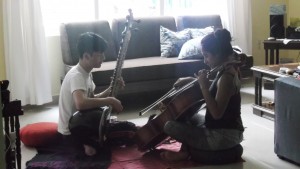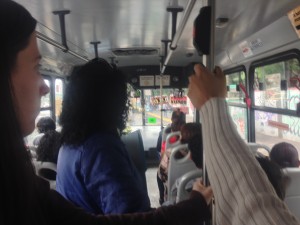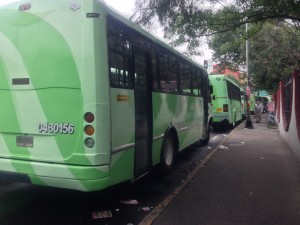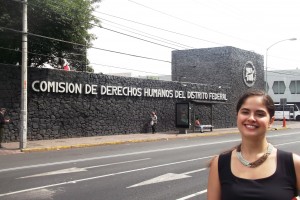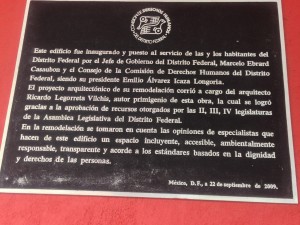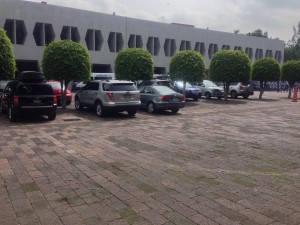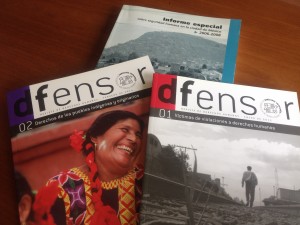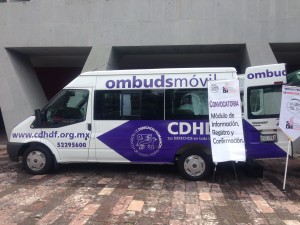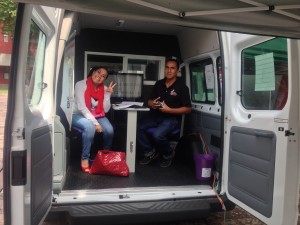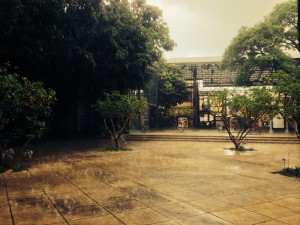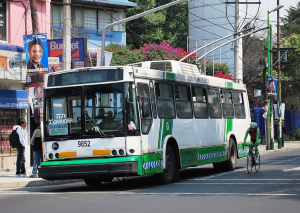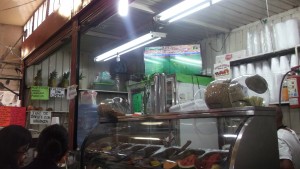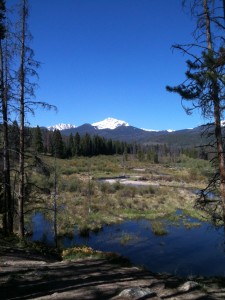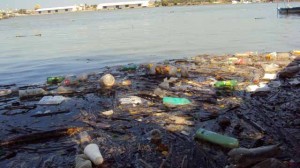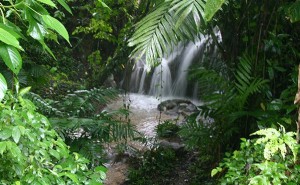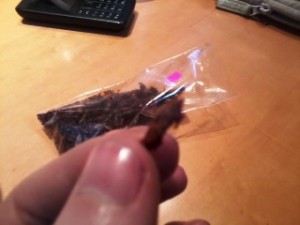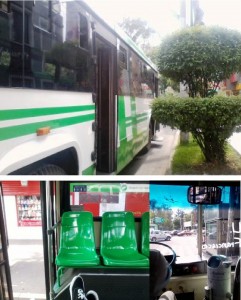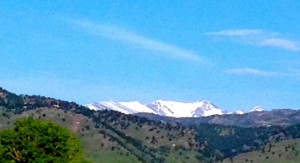Archive for category Mexico
The house of musicians
Posted by Ainhoa Martinez in Ainhoa Martinez, Mexico on June 24, 2014
It’s been more than 2 weeks since I landed in Mexico City and every day I discover new qualities of the people who are around me, which actually fascinate me.
The area where I am living is close to the School of Music and because of that, it is easy to come across with musicians or music students. In fact, two of my roommates are studing music: Hugo plays the piano and Carina plays the Cello.
When it rains heavily here, it is almost imposible to work on the field (floods, traffic jams, electric storms…) and some days we just try to gather information and write to contacts from home.
Last day, while I was studying important facts about water conflicts in Mexico I had the opportunity to join Carina and her Sitar player friend in their rehearsal afternoon.
Becoming a professional musician requires countless hours of rehearsals, so that’s what they did: 8 hours of non-stop music. Thank God I liked it, this is not a house for those who don’t like listening to music.
It was a nice afternoon: it was raining outside, Carina prepared her delicious black tea with ginger and cinnamon and lighted some incense.
Music and art cultures are truly rooted in Mexico City and you can find a lot of free daily events in the city center.
This reminds me of when I started playing the guitar, but had to leave it because of the lack of time. I don’t see myself becoming a professional musician, it is just a hobbie. But I hope Carina succed in her field, she is a talented woman and a dreamer. And who knows, maybe in the future I’ll be sitting in an auditorium enjoying one of her concerts.
Please, enjoy this short clip showing their talent:
A visit to D.F.’s Human Rights Commission
Posted by Jessica Sanchez in Jessica Sanchez, Mexico on June 20, 2014
Today, Ainhoa and I tried yet another mode of transportation. Called a, “micro” or “pesera” these are independent buses that travel to various destinations and cover routes not frequented by government transportation systems.
One of these “micros” transported us to D.F.’s Human Rights Commission (CDHDF), a local organ with its foundations in Mexico’s constitution, and an authority autonomous of the local and federal government. I was pleasantly surprised by the Commission’s atmosphere and quickly noticed a stark contrast between it’s environment and that of CONAGUA, which we visited this past monday. Not surprisingly. I can really only think to describe our interaction with CONAGUA as bureaucratic.
CDHDF on the other hand was quite the opposite. I’ve passed the Commission numerous times throughout my time in Mexico, it happens to be across the street from one of my favorite parks in D.F., called Viveros. From a major avenue, Universidad, the Commission welcomed us with big bold letters. Built to reflect its theme of transparency, its open spaces contain plenty of glass, both inside and out, full of friendly-faced staff and citizens waiting to be assisted. We were greeted with open arms by a Director, who made every effort to answer our questions and provide us with the Commission’s materials. He informed us that it’s the Commission’s job to assist any individual, free of charge, on human rights issues, whether they walk-in, phone-in, or file a claim online.
We got to see the Commission’s new Mobile Ombuds vans, that are to travel around the city for individuals to receive assistance. They basically look like mobile offices, as pictured below.
I left the Commission with a feeling of excitement. Glad to know we’ll be returning soon and hoping to speak to many others. I guess that’s the difference between visiting an organization who sees water rights as a human right, CDHDF, as opposed to an organization that sees water simply as resource to be distributed.
After we left, we stopped for a bite to eat nearby right before a heavy rainfall. Left without an umbrella, we were stranded for a while inside a coffee-shop.
This is not the first time the rain keeps us waiting, and I’m quite sure it won’t be the last.
Sharing a meal with my Mexican friends
Posted by Ainhoa Martinez in Ainhoa Martinez, Mexico on June 19, 2014
Since the very first moment I arrived to my home in Mexico City, I got on well with my rommates and I promised them I would cook Spanish omelette for them one day.
Well, it’s been almost 2 weeks since I landed here and it was time to prepare a nice dinner, so last night I was the chef.
The Spanish omelette is one of the most popular and tasty typical meals in Spain. I have to say I’m good at cooking and although desserts are my speciality, this time I wanted to share what my mum and granny taught me.

Cut the onions and the potatoes into small squares. Put some salt and fry them in the pan. Then, add some eggs, let it finish cooking and bon apettit.
I like sharing views, traditions and thoughts with people from other cultures. I am lucky I have been able to travel to different countries and have learned a lot from others.
Last night, Carina (one of my rommates) helped me preparing the dinner and we tried to add a Mexican ingredient to the Spanish receipe: the Nopal.
The Nopal is a plant grown in Mexico, with a lot of fiber and it tastes and looks like a pepper (more or less). The Spanish omelette with the Nopal was delicious.
A crucial moment while cooking a Spanish omelette is “the flip movement”. When the eggs are added and one side of the omelette is already cooked, but the other is not, you have to flip it. It can be difficult sometimes, but you can improve with practice.
At the end of the night we enjoyed a nice meal. Hugo and Carina (roommates) also prepared a lemon pie, which was exquisite.
Next time: Mexican spicy food (I hope I can stand the spicy).
Our first interview! Plus flooding, more flooding, and the World Cup.
Posted by Jessica Sanchez in Jessica Sanchez, Mexico on June 18, 2014
Yesterday, aside from early, the day was off to a rainy start. You see the weather in D.F. is unpredictable, so much so that its predictable. Every day will bring rain, overcast skies, a scorching sun and dry heat. That means pulling-off an outfit versatile enough to keep you cool, warm, and dry – every day. It’s actually become a joke between a friend and I, to see who’s outfit can make it through the day’s weather the best. I can’t complain, it’s really made me a pretty skilled dresser.
I digress, back to the beginning of the day. At 8:00 yesterday morning I took what locals call the “trolebus”, a public transportation bus that runs electrically off wires connected to poles throughout the city, to my partner Ainhoa’s place in Coyoacan.
At 9a a driver from CONAGUA, Mexico’s National Water Commission, picked us up and we traveled about 30 minutes crossing into Mexico City to CONAGUA’s facilities in Texcoco. As we drove out from D.F. we slowed numerous times due to flooding, even though the morning rainfall was light. This happens often. Anytime it rains, there’s flooding all over the city, causing major traffic jams and slowing public transportation, even the metro.
Though D.F. is notorious for it’s chaotic traffic, our drive was smooth and seeing as neither Ainhoa nor I get to travel by car much, we simply glared out the window, marveling at the size and diversity of the city. Crossing under bridges, past stadiums, colorful buildings, streets vendors and more, I sat silent, amazed by the many sites I had never seen.
At Texcoco, we learned about the origins of Mexico City and how its foundation was laid atop a body of water, which has plenty to do with the inundations that plague the city to this day. We then headed back to D.F. to another of CONAGUA’s facilities, where we finished there at around 1:45p. We headed back to Coyoacan with our driver anxious to drop us off to return and watch the Mexico v. Brazil game in the World Cup. We got dropped off near a market, where every restaurant, niche and stall had a television tuned into the game. There was plenty of emotion in the air, as the sounds of excitement or disappointment filled the market with every play.
What a time to be in Mexico.
Fallow Fellow Fumblings
From the relative comfort of my rocking chair in Boulder, smut novels and bon bons nestling with Medusa thoughts writhing about colorful balls of inertia in the bottom of my knitting basket, it is easy for me to flip the remote to the Self Pity Channel: “I wish I were on the ground doing good!”
I’m not battling taxi drivers, mosquitos and food poisoning. I am not bearing the haunted glances of parched children as flats of water bottles march by in perfect formation. I am not being immersed in the futility of promising initiatives that are smothered by corrupt politicians. I am not wending my way through imposing barriers while children are being rousted from their homes and neighborhoods on the pretext of crimes they did not commit.
I am luxuriating in hegemonic bliss as I await my opportunity to travel to another country to explore, learn about and tell the stories of others impacted by conflicts over one of the World’s arguably most precious resources: WATER! Yet I am gratified to learn that I am not totally divorced from the on-the-ground experiences of my fellow fellows. In fact, I have been repeatedly head butted by Phoenix’s friend, Serendipity, who found her way from Ethiopia to the foothills of the Rocky Mountains of Colorado.
I have become a veritable witching rod for all things water related. People off the streets run up to engage in random conversations about water quality. Folks in coffee shops bury me in literature about the various nefarious wanderings of water development through American history. Hay farmers crop up to share water adjudication and allocation woes. Human rights activists stop to commiserate about the loss of already limited arable reservation land to dam (damn?) projects.
All of this serendipitous water schooling (I swear, I have done and said nothing to invite this inadvertent education!) keeps pushing an uncomfortable thought to the forefront: Is my penchant for seeking out problems in other lands, a simple case of development myopia? I have been born, raised and educated in a cauldron of water issues, yet, up to this moment, have refused to see it. Am I the proverbial frog who has acclimated so steadily to this environment of conflict that she failed to note the transition from tepid to scalding?
Harrowing thoughts for a barren mind.
Rainy days in Distrito Federal
Posted by Ainhoa Martinez in Ainhoa Martinez, Mexico on June 16, 2014
Climate is crazy almost everywhere and in Mexico City it will not be less than in other places.
We can feel 3 different seasons during a day: it is cold early in the morning, high temperatures and humidity when it gets to midday and almost every nightfall it rains.
There are some particular farmers in the Basque Country, who know a lot about climate change. I remmeber watching a documentary about their weather forcast when I was a child and I won’t never forget what they were explaining: “If the clouds are pretty bad, it means that something bad is coming. Its appearance is directly related to the climate that can change at any time”.
I was able to check that fact the other day when I went to take out the trash.
Thunder is heard, the clouds are pretty bad, it starts to get windy and temperatures drop.
You have to be careful when walking through the streets when heavy rain is coming, the traffic goes mad (normally it is crazy, so imagine if it is rainning) :
This is the road next to my home here in DF. My roommates and I were trying to cross the street after buying some pizzas in OXXO.
It was even worst at night. Electric storms joined the heavy rain:
What I usually do is to check the weather on the Internet in a website that tells you what is going to be the weather like hour by hour. However, I recently experienced it is not trustworthy.
Last week I left my umbrella at home and this was the result when I came back:
Lesson learned: bring always the umbrella in your bag, no matter if you know it is not going to rain that day, weather can suddenly change.
The World Cup v. Mexico’s Energy Reform, 1:0
Posted by Jessica Sanchez in Jessica Sanchez, Mexico on June 15, 2014
As previously mentioned, I arrived in Distrito Federal roughly nine months ago in search of an understanding of the newly evolving Judiciary. It was not until the past few days, however, that I got the opportunity to observe a different side of the Mexican Government, its Legislature. With it, have come a few surprises.
This past week saw the beginning of discussions on energy reform initiatives for secondary laws presented by President Enrique Peña Nieto in April 2014. The Mexican Senate designated the job of discussing initiatives affecting 21 secondary laws to the Joint-Commissions on Energy and Legislative Studies. The objective of discussing these laws, some new and some amended, is to provide procedural regulations through which the implementation of the constitutional reform on energy may take place. Up to this point, the phrase “energy reform” might sound like a good thing. For those who might watch mainstream Spanish channels, they might be convinced of this. Unfortunately, this is far from reality. The novelty of President Pena Nieto’s reform is that it breaks the stand taken by President Lazaro Cardenas seventy-six years ago to nationalize Mexico’s oil industry. The reform effectively opens Mexico up to foreign investment, accompanied by exploitation of its land and natural resources, including its increasingly scarce fresh water supply. The biggest threat is what has been termed as “fracking”, a method of extracting natural gas from shale reserves deep in the earth’s subsoil. Invented by U.S. oil and gas giant Halliburton, fracking has spread throughout fifteen U.S. states with numerous “fraccidents” reported, and many vigilant states fighting to keep it out of their towns and away from their water sources.
I have taken the time to watch the Joint-Commissions, and observe, for the first time in my life, how the Mexican Legislature handles itself. I was also interested in watching the country’s primary parties, PRI (center), PAN (right wing), and PRD (left wing), along with others, discuss one of the most important reforms in Mexico’s history. I would never have anticipated what I’d see next.
The discussions began June 10 and quickly it was obvious that there was strife between the parties. On the one hand were PRI and PAN Senators. Holding the majority of votes, they sat smug, calm and collected, not to mention often distracted by their cell phones. I quickly felt put-off by their demeanor and condescending address of the issues. While their PRD counterparts, with the minority of votes, displayed themselves aggressive, wide-eyed and often highly offended. I’d never heard politicians speak so blatantly about the other party, and much less about the laws being discussed. It was an all-out soap-opera drama, live and on-air, and I mean that in a good way. The PRD Senators blamed the PRI and PAN for working together to approve initiatives that open Mexico up to a world of exploitation, to the detriment of the very people they’re suppose to represent. I was very surprised. I am not one who is very fond of politicians in general, but the PRD members’ candor, their well grounded oppositions, and most importantly their passion for the people they stand to represent, was moving.
In the last few days it has become obvious that PAN and PRI have little, if anything to change, much less discuss with regards to the initiatives proposed by the Executive. The reason for this and the PRD’s reactions became clear in media interviews, where a PAN Senator blatantly admitted PAN and PRI had already reached an 95% agreement on the initiatives, with the Executive, and without the opinion of PRD members. All before even having completed discussions on the first of four debates on the initiatives. In other words, the debate is not a debate. With the majority of votes held by PRI and PAN, they will continue to sit back and carry on with the discussions, but only for procedure’s sake. While PRD members can only carry out their arguments in hope that the Mexican people are watching and listening. Unfortunately, PRD lost the battle to have the discussions held after the World Cup. So chances are the majority of the country will be watching the scoreboard, with few listening to the warnings given by PRD about the dangers that loom with the energy reform. I can’t help but feel extremely disillusioned and disheartened by the discussions in the Joint-Commissions.
Though I am well aware of the corruption issues plaguing this country, the discussions display a level of disregard for the future of the country that leaves me truly astounded. If Mexico’s politicians are so readily available to sell out their country’s oil reserves for economic incentives, how can they be expected to protect the public’s right to it’s most fundamental resource – water?
Mexico, the environment and water issues
Posted by Ainhoa Martinez in Ainhoa Martinez, Mexico on June 12, 2014
The Mexican environment is a gift from the Mother Nature. The view that the environment provide is infinite, from the snow-capped volcanoes in the southern Valley of Mexico, to the full of cactus deserts commonly seen on Mexican movies, the wild jungles and the heavenly coast areas.
Respecting environmental issues, although Mexico is an oil producer and a developing country, it might be surprising that Local Government has manifest its aim to reduce the greenhouse gas emissions and had the objective to reduce them to half by 2050. Will they achieve that objective? These days the Energetic Reform is being discussed in a Commission at the Mexican Senate.
The geographical location of the country makes Mexico vulnerable to global warming and these last years, events such as hurricanes, droughts and floods may be attributed to the increase of the sea temperatures.
In addition, while its oil production decreases, Mexico discovers its potential for renewable energy. One-sixth part of its electricity comes from hydroelectric dams and also seeks foreign investment to develop solar energy.
Regarding water conflicts, the South territories of Mexico hold the 70% of the water, however, the North and the Central territories hold the 75% of the population. In total, about 11 million Mexicans (the 10% of the population) have no running water at home, and 15 million are living without sewage systems.
The aquifers in the North and Center are under increasing pressure from the cities, industry and agriculture. The North has suffered several droughts in the last two decades, which had affected agricultural production. And Mexico City turned to water shortages in 2009 due to a shortage record.
A lot of water is wasted. Because of leaks, about the half of the water supplies of the cities is lost. And about the half of the 75% of the country’s supply for agriculture is not used productively.
About the 80% of sewage water is not treated, which together with the waters of agrochemical runoff and large amounts of waste discharged into rivers and lakes, causes the contamination of the three quarters of the surface waters of Mexico (more or less).
Much of the sewage water from Mexico City is poured into the Panuco River, which empties into the Gulf of Mexico in Tampico. The Lerma River, which also caters to the capital, receives sewage water and industrial fluids in many other cities on their way to Lake Chapala, the largest natural lake in the country.
Jungles are also important as their conservation is key not only to fight against global warming, but also because they often are the source of water supplies.
The problems of the Federal District in terms of water supply, wastewater treatment, overcrowding and traffic pollution are reflected on a smaller scale in all rapidly growing cities.
Tourism development involves large-scale problems and threatens fragile ecosystems, especially in Baja California and the Caribbean coast. Due to uncontrolled urban development, new buildings threaten to deplete water resources, increase pollution and destroy wetlands.
Nevertheless, environmental awareness is growing stronger, but still there is no movement on a large scale, but you can find local organizations such as Pronatura, which allocates 100 million MXN to projects regarding climate change, priority species and land conservation.
Agur Basque Country, Hola Mexico!
Posted by Ainhoa Martinez in Ainhoa Martinez, Mexico on June 10, 2014
5.30 pm of Thursday the 5th, I have just finished the last exam of my LLB. I cannot believe Law School is now over and in less than 2 days I will be on my way to Mexico City. A good plan for my last hours in Vitoria-Gasteiz? To have dinner with my best friends in one of our favorites Italian restaurants and have some drinks.
The day before starting my trip I had lunch with my family, packed up everything I need for the trip and said goodbye to my beloved family and friends.

See you soon girls!
Having some drinks after dinner with my best friends in Vitoria-Gasteiz, to celebrate we have finished our LLB and my trip to Mexico.
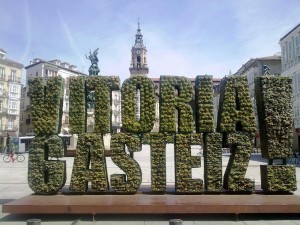
Hometown.
Vitoria-Gasteiz is where I live. It is the capital city of the Basque Country and in 2012 it was awarded as the European Green Capital. This monument made of shrubbery was designed to represent the award and it stands in the center of the city.
I have been lucky because 4 days before my departure I got in contact with a woman who was renting a room for students in the area of Coyoacan, where Jessica is living. I saw the house and the room via Skype and we reached an agreement. So having solved all this issue about accommodation, before my arrival to Mexico City, have been truly handy. I will not have to go mad booking a hotel room and wondering around the city looking for a place to live.
4 am of Friday the 7th, the airport is just one hour away from my home and is easy to get there. First I will travel from Bilbao to Paris and then get the flight to Mexico City. There were so many security controls between Bilbao and Paris and the Parisian airport was so big that I almost got lost, but I finally reached the gate for my flight and as I had 3 hours left until the departure I had lunch in one of the restaurants. Got my tickets and passport ready to take my sit in the flight, if you had ever travelled such long distance you will guess I am sitting next to the corridor because your body and mind can get really tired during the 10 hours of journey and it is good to walk every hour to avoid having pain in your knees, ears or headache.
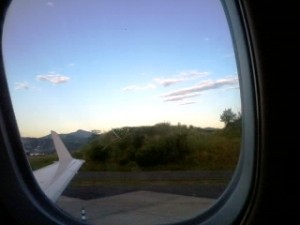
The plain is about to take off.
The journey starts in the airport of Bilbao. Incredible view from the window, the sky is quiet and calm.
Finally I landed in Benito Juarez International airport at 6.30 pm local time. There are 7 hours of time difference between Mexico and Spain and I hope the jetlag does not catch me. I went through the migration controls and got my luggage. One more thing to do before I walk over Mexican floor: I had to press a button and if the light goes green I walk forward, but if the light goes red I have to open my luggage to be inspected. Please go green, please go green… It’s green light! Thank God! I was so tired I did not want to start taking everything out of the luggage.
From 6 pm onwards it’s rush hour in the Mexican airport because it is the arrival time for most flights coming from Europe. The place was crowded, but I finally found Jessica and we took a safe taxi to get home. During the journey, the long roads and the old buildings I she through the window of the cab reminds me of the summer I spent in Beijing. Everything looks more or less the same, like a massive city, full of traffic, where wealth and poverty are separated by only a few steps.
First must-to-do things in Mexico City:
1. Settle in the house.
2. Walk around the area and locate important places such as public transport areas, restaurants and supermarkets.
3. Do the shopping! (you must be starving).
4. Find secure taxi numbers, maps and other practical information.
5. Get a Mexican cell phone. It can be easily bought in OXXO or Moviestar shops for 300 MXN.
And do not forget to try “Chapulines”, if you don’t try them you won’t live the Mexican experience. Jessica took me to a little place in Miguel de Quevedo Avenue and bought some. I just tried two and it was a mixture of spicy and salt with a lot of proteins. For a non Mexican person it was very spicy, as Mexicans say “Me enchilé”.
Regarding the Coyoacan area, I really like the house where I am living, there are 3 more students living here and every Monday and Friday a housekeeper cooks for us traditional Mexican food (I hope I can share with you a blog entry on this issue in the future). The first morning I woke up and found a welcome message written on the board of the kitchen. Rita, the owner of the house, prepared me a huge and delicious breakfast to recover from the long journey and the other students living in the house and I started talking. It seems like we have a lot in common, two of them are studying music and I play the acoustic guitar and the ukulele. The neighborhood is calm and both public transport and supermarkets are close to the house.
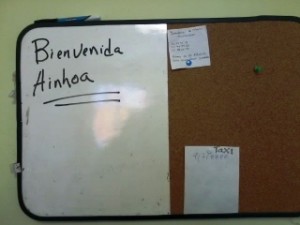
Welcome message.
Rita (the owner) and other students living in the house left me a welcome message written on the board of the kitchen, followed by a delicious and energetic breakfast the morning after my arrival.
Jessica and I decided to stablish our meeting place in a Starbucks, which is halfway between her home and mine, we have like a 10 minute travel by “Trole-bus” to get there. It is funny the first time I took the Trole-bus alone, it suddenly broke down and had to wait a lot until another one picked me from the middle of nowhere, but it was okay and I easily found Jessica.
We spent my 3rd day in Mexico City walking through the main streets of Coyoacan and it is such an active and full of live place where you can find different street markets, parks, all the food shops that you can imagine…
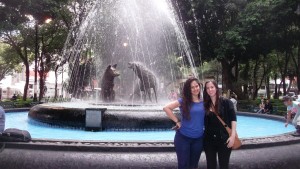
The center of Coyoacan.
This is Jessica and me, standing in front of a fountain in a park. The 2 coyotes in the middle of the fountain give the name to this beautiful area, Coyoacan.
My way back home early at night was such a challenge for me because more or less I could locate myself in the area during the day, but the sun had already gone. There was no problem, I took another Trole-bus to “Taxqueña” main street and just had to walk a couple of streets to reach home. So the first day walking around the place alone went pretty well.

On my way back home at the end of the day.
Here you can find one of the OXXO shops, which are so popular around the city.
Life in Mexico seems to be very “relaxing” so we had better not to be in a hurry if we need to do something. That could summarize the Mexican way of living.
P.S.: “Agur” means goodbye in Basque language and I suppose everyone will know that “Hola” means hello.
From Peak to Peek
Though not within the purview of this particular study of water conflicts in Mexico, Long’s Peak rises in my backyard as a reminder of the juxtaposition of Nature’s majesty and the barren wasteland that lies at the end of her convoluted resource chain.
It is from this peak that the headwaters of the Colorado River flow, winding their way through Colorado, Utah, Nevada, Arizona and California, before crossing the cartographer’s line into Mexico.
En route, the Colorado is diverted, reverted, pumped, dumped, silted, salted and dammed, until it sludges onto formerly productive agricultural lands south of the border: “The Colorado, a river whose importance is absurdly disproportionate to its size, has the worst problem with salt of any American river.” [Marc Reisner in Cadillac Desert at 460.]
Treaties and litigation appear to have had little long-term mitigating impact on a burgeoning resource allocation and preservation issue that pits power brokers against politicians, farmers against taxpayers, and peoples of states and countries against one another.
The views at either end of the Colorado River’s tortuous journey through time, furrows and canyons, could not be more diverse . It will be interesting to see whether the conflicts that are carried downstream along this river and its tributaries bear any resemblance to those that we will encounter as we launch upon our own travels through time and space.
